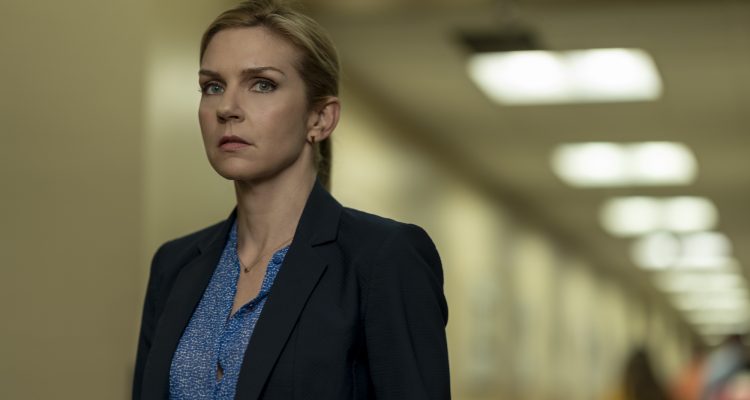Over the past five years, actress Rhea Seehorn has electrified critics and fans with her dynamic portrayal of Kim Wexler. the laser-focused attorney who goes toe-to-toe with Jimmy McGill (Bob Odenkirk) in AMC’s Better Call Saul.
In the penultimate season of the Breaking Bad prequel, Jimmy McGill has fully embraced his Saul Goodman persona, earning a steady supply of not-so-safe work from cartel boss Lalo Salamanca (Tony Dalton). Jimmy’s transformation has some unintended, incendiary consequences for his relationship with Kim, allowing Seehorn to carve new ground for the character. “I saw that something was eroding in Kim for multiple seasons,” Seehorn shares.
Odenkirk had high praise for the complexity Seehorn brings to the character, sharing his take on the series as it stands today. “At first, the idea of the show was ‘Who is Jimmy McGill?’ Now, it’s ‘Who is Kim Wexler?’”
It’s no secret that Seehorn’s work ethic mirrors that of her onscreen counterpart, constantly running lines after long days on set. During production, Seehorn and costar Patrick Fabian live with Odenkirk at his Albuquerque home. The situation has proven to be a godsend for the stars, as they swap parts and polish the material. “You basically need to hide in your room if you don’t want to run lines,” Seehorn says.
Seehorn spoke with Awards Focus about life on the Albuquerque, New Mexico production and Kim’s surprising journey in season five, ultimately stepping down from her firm whilst hatching a plan that could decimate fellow attorney Howard Hamlin (Patrick Fabian).
Awards Focus: The reception for Better Call Saul and your work this season has been incredibly positive across the board. The Rolling Stone profile was particularly insightful. How was that experience?
Rhea Seehorn: It was great, I love Alan Sepinwall’s work. He writes very intelligent recaps and thoughtful pieces about the storytelling and the character development that goes on in our show. I think it was the last live interview I did, we met in a coffee shop a couple of days before people realized we can’t go outside anymore.
AF: In the season four finale, Kim was stunned when Jimmy revealed his emotional speech to get his law license reinstated was just a performance. She’s left standing in the hall as he races off to change his name to Saul Goodman.
This year, it’s Kim’s turn to leave Jimmy on his heels. Were you shocked when she left her work on Mesa Verde and subsequently started brainstorming about decimating Howard’s career to get Jimmy his Sandpiper case money?
Seehorn: Well, to be fair, it is a series of decisions. I saw that something was eroding in Kim for multiple seasons. And what I appreciate about our series, like Vince (Gilligan) and Peter (Gould) did with Breaking Bad, it’s about incremental decisions that these people are making. They’re unaware that they’re falling off a complete cliff. I didn’t know what that final scene was going to be. But I took every step that was handed to me with the information she had presently and played that scene.
AF: You’ve said you’ve seen erosion going on in Kim, can you speak more to that?
Seehorn: The beauty of the show is that these characters are so affected by their past, not only by the events we’ve seen on the series but even before that. From the beginning of the series there was something about Kim’s stillness and her need for control and to right every ship. When I looked at that, I asked “What are you trying to get away from?” or “What are you suppressing that’s so chaotic that you need to make sure that everything is steady all the time?” Those questions spoke to me about the changes we’re seeing in the latter half of this season.
AF: So there’s a potential “Slippin’ Kimmy” underneath the Kim we’ve come to know?
Seehorn: About halfway through the season, Peter (Gould) said that he and the writers started thinking about the masks we all wear and what’s behind Kim’s mask. I will be very interested to see if she follows through with the decimation of Howard Hamlin and can she stomach those actions? Is she a person now who doesn’t even have a conscience? When she shoots the finger guns at Jimmy, there’s a menacing undertone that certainly concerns him.
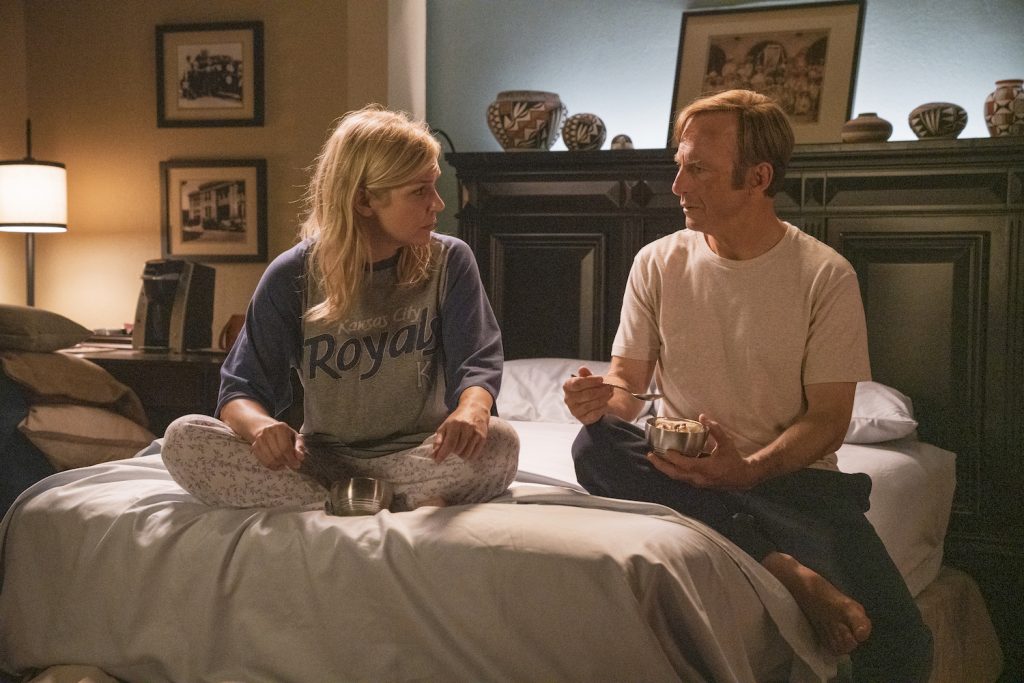
(Photo Credit: Greg Lewis/AMC/Sony Pictures Television)
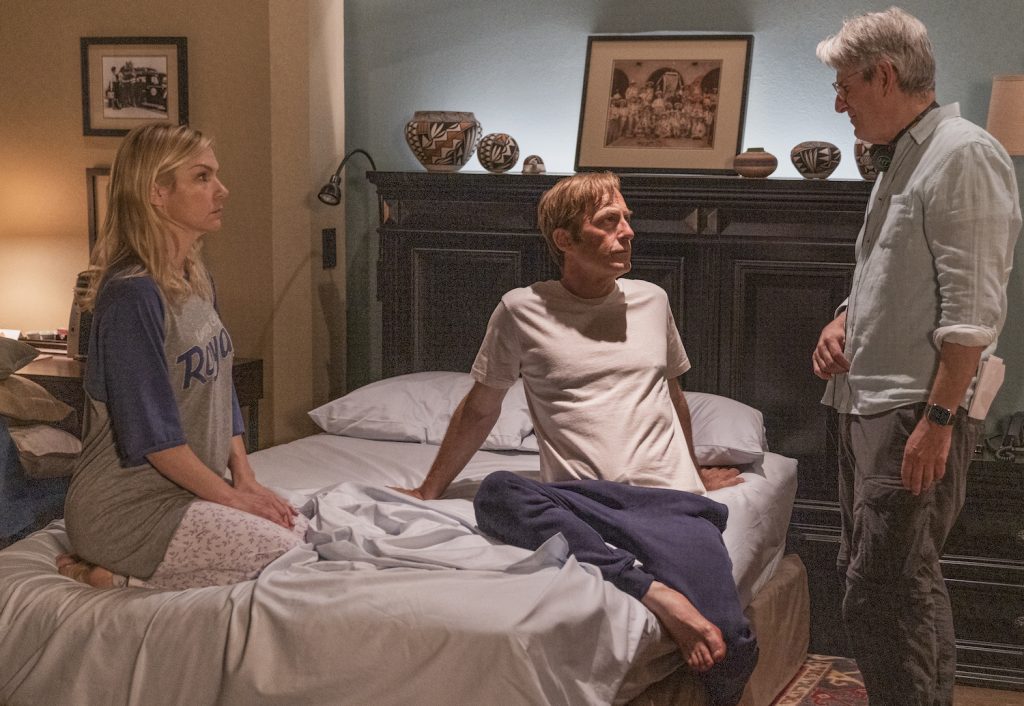
(Photo Credit: Greg Lewis/AMC/Sony Pictures Television)
AF: There’s so many telling moments about Kim’s character. The moment when she and Jimmy are throwing the beer bottles off the roof, but Kim cleans up the glass the next morning. If Kim does goes through with this plan for Howard, do you think she would follow suit in some sort of attempt to clean up that mess as well?
Seehorn: That’s a good question. If Kim goes through with her plan, there may no way for Howard to recover. Michael Morris directed those beer bottle scenes, I love how they tie the episodes together. The first one where Kim had some animosity about her saying the name Saul Goodman and then when they’re tossing the bottles together it’s a bonding moment.
AF: Bob (Odenkirk) has spoken about living with Patrick (Fabian) and yourself in Albuquerque. Can you give our audience a look into the behind the scenes life during production?
Seehorn: The three of us have been living together for the last two years and prior to that Bob and Patrick lived together for a season without me. Frankly, I wish we’d been doing it the whole time. It’s so helpful because the scripts are so dense and complex and you’re always wishing you had more time to play with them and find new things.
AF: As you’ve pointed out, the scripts are often dense. When you have a dialogue heavy episode, how much of that preparation is just getting a grasp on the material?
Seehorn: A lot of it. Jonathan Banks and I laugh because we have the same philosophy. If you think you’re off book, then you need to ask yourself, “Are you off book riding a bike? Are you off book standing on your head? Are you off book swimming in the ocean?”
You think you know your lines and then as soon as you’re asked to do something, or you try blocking, or your scene partner decides to do whatever they’re going to do, the words start to slip away from you. There’s just no time for that with our shooting schedule, not if you want to bring your A-game.
AF: Is there a general time set aside for working through the scripts at the house?
Seehorn: If you’re having a cup of coffee in the main kitchen, you’re gonna get asked to read lines. You basically need to hide in your room if you don’t want to run lines, because if you are seen or visible anywhere in the house, you’re going to get asked. And we run lines that are not our scenes too. Like if Howard has a scene with someone else, then I’ll be whoever he’s talking to and it’s great.
AF: The scenes between Lalo (Tony Dalton) and Kim are incredible this season. Before we dive into specifics, talk about working with Tony and his presence as Lalo.
Seehorn: I mean, how great is Tony? What a find that Sherry Thomas and Sharon Bialy brought to Vince and Peter. He’s so talented, but he’s also a very generous actor. It doesn’t matter if he’s not talking for the majority of the episode nine confrontation, he’s giving me so much in that scene once I’m toe-to-toe with him.
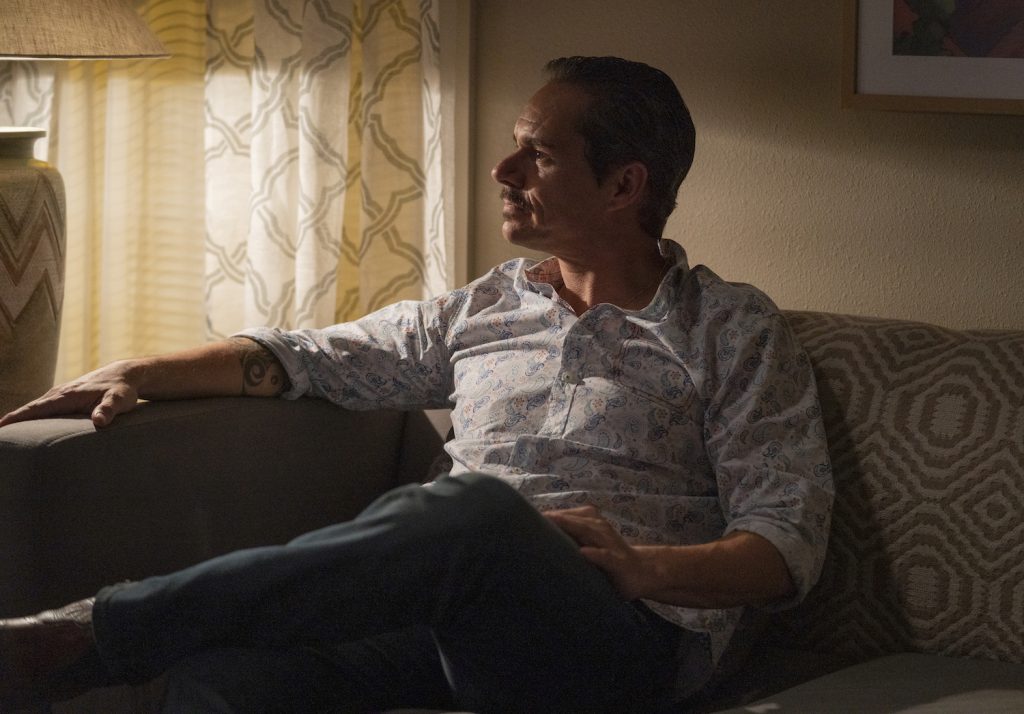
(Photo Credit: Greg Lewis/AMC/Sony Pictures Television)
AF: We saw a different Kim when she meets Lalo in jail. Can you talk about crafting that confrontation?
Seehorn: I spoke with Gordon Smith, who wrote episode eight, about the idea of when is Kim off her game? Because previously, we’d seen that she can fall apart in a stairwell or at home, but once she walks into a courtroom or a meeting, she suppresses all of that, and can be totally professional.
So, I went in there questioning “Do we think she can actually hold herself together right now?” We decided that she probably hasn’t slept at all and she knows this is a very scary situation. She’s pretty sure that Jimmy is dead or dying in the desert right now and she can’t call the police and tell them what happened. So, she’s trying to get information from Lalo and she’s unsuccessful in that scene whereas in episode nine she is successful.
I like that Kim got two attempts to go at Lalo using intelligence and rhetoric. The second one in episode nine, written and directed by Tom Schnauz, was a monster of a scene and we knew it.
AF: What were some of the logistical considerations for the episode nine faceoff?
Seehorn: Tom came to Bob and Tony and I, and asked if we could rehearse it on set. It’s technically a difficult scene, I have the big monologue at the end, but Tony has to play a lot of different things as he’s reacting to what he’s hearing from Bob and then Kim.
For Bob, he has to repeat the same story but slightly differently, I think four times, which for an actor is very hard material to memorize because you lose track of where you are in the loop. Tom had written in purposeful nuances as Jimmy sort of devolves in his storytelling.
So we rehearsed it, and thankfully we made a lot of decisions with Marshall Adams (the director of photography) and our camera ops and lighting people. That allowed us to get ahead of the curve and give ourselves the hours that we had to shoot it instead of losing time on the technical aspects.
AF: At the beginning of that scene, you have to be very present for Bob and Tony, conveying that sense of dread and uncertainty that Kim feels. What’s going through her head there?
Seehorn: Kim is in survival mode for the first half of the scene. She’s very still, but she’s practical. I think she’s immediately thinking, “Could we jump from this balcony? Where are the knives in the house? Could Jimmy and I take him if we had to?” Eventually, she’s run out of options and is left with observing Jimmy and what unfolds in front of her.
AF: Kim knows that Jimmy is lying to Lalo and that Lalo either suspects it or knows it.
Seehorn: She knows there’s a secret involving the bullet hole in the mug, and that the secret is so great that Jimmy is literally crumbling in front of her and it needs to be protected at all cost for some reason.
AF: And then Kim steps up to the plate, which was the most harrowing moment of the season. Were you always meant to get so close to Tony, having Kim invade Lalo’s space like that?
Seehorn: Yeah, that was in the script. I spoke to Jennifer Bryan, who’s brilliant with our costumes, and I said, “Kim’s coming from work so she has her heels on… do you think we can get the shoes off in the scene?” I talked to Tom Schnauz about having Kim’s shoes off because I wanted to be even physically smaller than Lalo.
Kim switches to pragmatism in that moment, that’s her fight or flight. She wants to go toe-to-toe like she’s proving a case, finding the holes in Lalo’s story and sewing enough doubt that he backs down.
AF: Do you think Kim prepared her argument while she was sitting there, listening to Jimmy?
Seehorn: I talked to Tom about that, I don’t think she memorized this monologue while she was sitting there on the couch worried. I think she starts it and has to find it. So, we made sure we did a couple of runs at that, just letting me find it and letting me constantly control that lump in my throat because Kim can’t become hysterical.
If Lalo sees that she’s emotionally terrified or starts screaming or anything like, she loses all she has, which is trying to present a logical, forceful argument that he really has to consider. You see Lalo shush Kim earlier on the scene, so I think she’s pretty clear what the cartel would think of women screaming or crying.
AF: Prior to Lalo, Kim’s biggest confrontation was with Mesa Verde client Kevin Wachtell (Rex Linn). The property tycoon was locking horns with Mr. Acker (Barry Corbin), an elderly home owner who refused to vacate his property.
Kim, feeling sympathetic to the man’s circumstances, recruits Jimmy to represent him — a move that nearly causes their relationship to implode. I don’t think anyone saw the idea for marriage coming, much less from Kim. What was your reaction to that?
Seehorn: That was something Bob and I worked extensively on, getting that moment to feel authentic. It’s also Kim accepting Jimmy for who he is, rough edges and all. In episode nine, Jimmy can’t accept Kim’s decision to quit Mesa Verde and she calls him out on it.
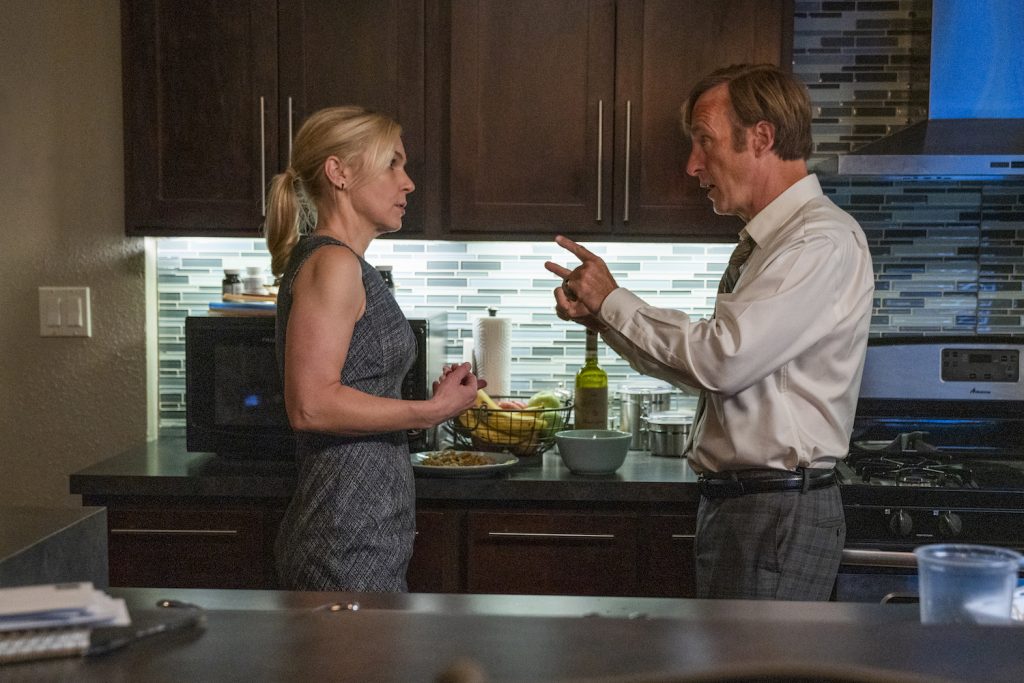
(Photo Credit: Greg Lewis/AMC/Sony Pictures Television)
AF: Knowing what we know from Breaking Bad and now El Camino, there are very few living characters in the Gene timeline that could give fans a meaningful, full-circle conversation as the series closes. Would you agree with the argument that Kim is the obvious choice for the final conversation with the Gene?
Seehorn: Honestly, I didn’t know I’d be alive this long. If I attempt to take myself out of the equation, which is super hard as an actor, I think the writers are always going to reach for the smartest ending.
Is it the most satisfying storytelling with Kim there at the end? Or is it not? I do agree with you that as a fan I want some resolution regarding Gene. Will we only get one more scene at the beginning of season six, or will it be expanded throughout that season? There’s another question for you.


